Marinated Presa Ibérica with Walnuts | Gourmet Spanish Pork Made Simple
Discover how to make Gourmet Spanish Pork Made Simple with this Marinated Presa Ibérica with walnuts recipe – a gourmet Spanish-inspired dish that’s perfect for dinner parties or special occasions!
Whether you’re preparing a gourmet Spanish pork recipe for a dinner party or simply want to enjoy a restaurant-quality dish at home, this Marinated Presa Ibérica with Walnuts recipe is a showstopper. It’s quick enough for a weeknight indulgence yet refined enough to impress guests, proving that great Spanish cooking can be both approachable and spectacular.
This cut of Iberian pork, prized for its tenderness and marbling, delivers a juicy, melt-in-your-mouth experience that rivals even the finest beef steaks. When marinated in a smoky-sweet blend of dark soy sauce, honey, paprika, and olive oil, the meat soaks up deep, complex flavors before being pan-seared to perfection.
The final touch—a sprinkle of lightly toasted walnuts—adds a delicate crunch and nutty richness that elevates the dish into a true gourmet experience.
This post may contain affiliate links.
Serving:
Tapas for 2
Ready in:
A few hours
Skill level:
Easy
Serve with:
Bread
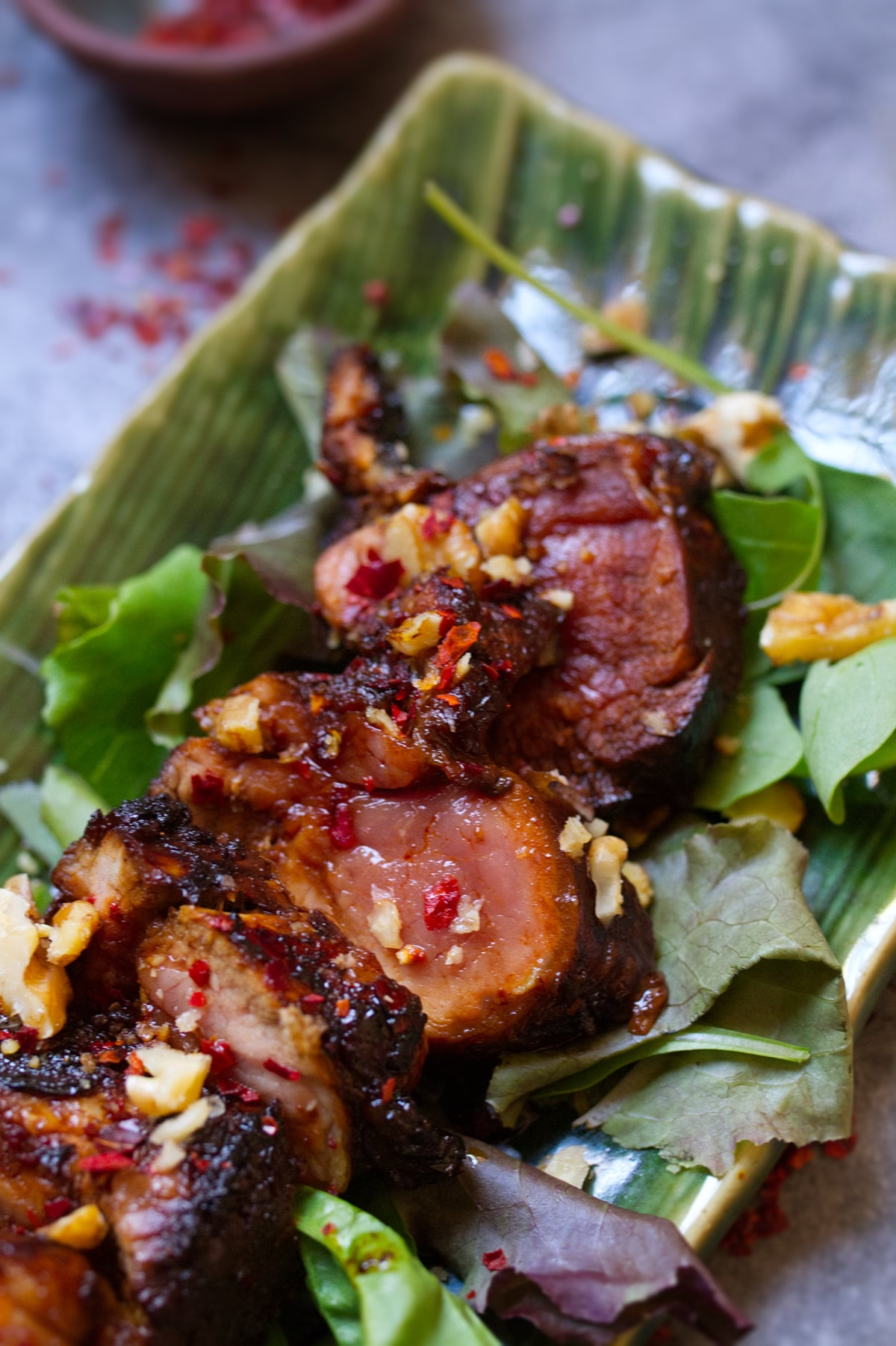
How to Make Marinated Presa Ibérica with Walnuts
Ingredients
- 2 pieces of presa ibérica (around 500g)
- ¼ cup Dark Soy Sauce
- 60ml Pedro Ximénez sherry (optional)
- 2 Tbsp Honey
- Extra Virgin Olive Oil
- 1 tsp Sweet smoked paprika
- 1 tsp Dried ñora pepper flakes
- Salt and Pepper (to taste)
- A few walnuts, loosely chopped
Equipment
- Large bowl
- Wooden cutting board
- Chef knife
- Cooking Tongs
- Large skillet or pan
Instructions
Step 1 – Marinate Pork
- Combine the soy sauce, honey, paprika, and olive oil in a large bowl. If using, add the Pedro Ximénez sherry.
- Mix well until the honey has combined with the soy and made a rich, slightly syrup-like sauce.
- Check flavoring and season to taste with salt and pepper. Note: Add more honey if you prefer a sweeter-flavored marinade.
- Add the pork and rotate in the marinade so each piece is evenly covered.
- Cover bowl with kitchen wrap and refrigerate for at least 2 hours (or overnight for best results).
Step 2 – Pan Fry pork
- Add a splash of olive oil to a pan on medium-high heat.
- Add each pork fillet and cook for around 2-3 minutes per side (around 10-12 minutes in total for medium-rare).
- Set cooked pork aside to rest for 2-3 minutes.
- Meanwhile, loosely chop a few walnuts and set aside.
Step 3 – garnish and serve
- Lay a bed of greens on a serving plate.
- Slice the cooked pork into bite-sized slices and add to the serving plate.
- Drizzle with some more soy sauce and garnish with a few chopped walnuts.
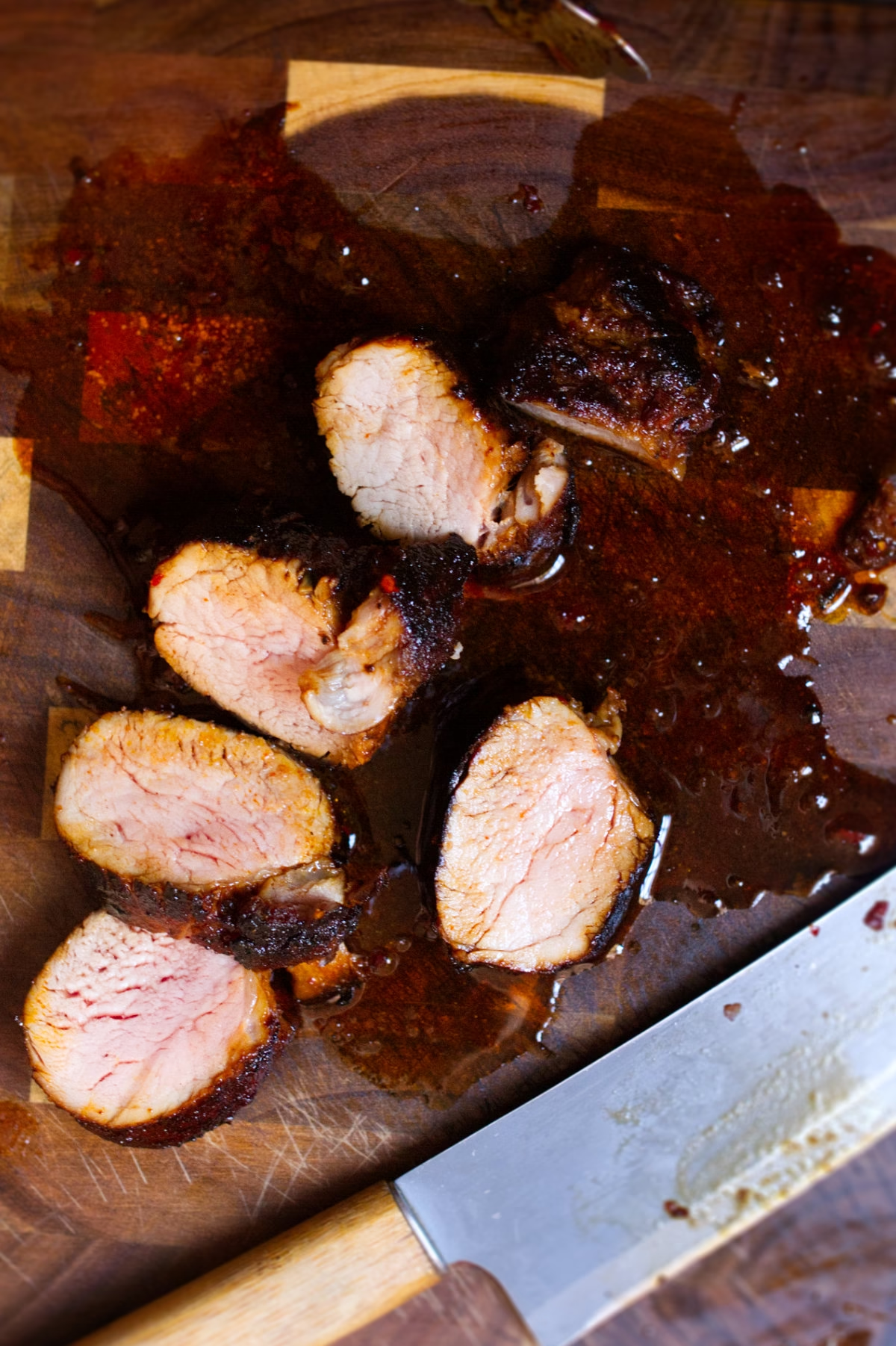
Serving suggestions
- Patatas Bravas – Crispy potatoes with smoky paprika sauce and garlicky aioli. A Spanish classic that echoes the paprika in your pork.
- Roasted Piquillo Peppers – Sweet, silky peppers dressed with olive oil and sea salt. Great alongside the pork.
- Ensalada Verde – A light green salad with bitter leaves, orange slices, and a sherry vinegar dressing — adds freshness and acidity to cut through the richness.
Chef’s Tips for the Perfect Marinated Presa Ibérica with Walnuts
- Marinate Overnight for Maximum Flavor – While 2 hours works well, letting the presa ibérica soak in the marinade overnight enhances its tenderness and allows the smoky-sweet flavors to fully penetrate the meat.
- Cook to Medium-Rare – This cut of Iberian pork is best enjoyed medium-rare to medium (about 58–62°C / 136–144°F internal temperature). Overcooking can dry it out, so use a meat thermometer for precision.
- Toast Your walnutss – Lightly toasting the walnuts before chopping brings out their natural oils and intensifies the nutty aroma, adding a gourmet touch to the dish.
- Pair with Spanish Wine – For the ultimate dining experience, serve your Marinated Presa Ibérica with Walnuts with a bold Rioja or Ribera del Duero. The robust red wine complements the richness of the pork beautifully.
A note on cooking times:
I like to cook this cut of pork to medium-rare, which takes around 10-12 minutes on a high heat. You’ll notice in the video that the center of the meat is very rare (pink). If you prefer a more well-done texture, increase cooking time to suit.
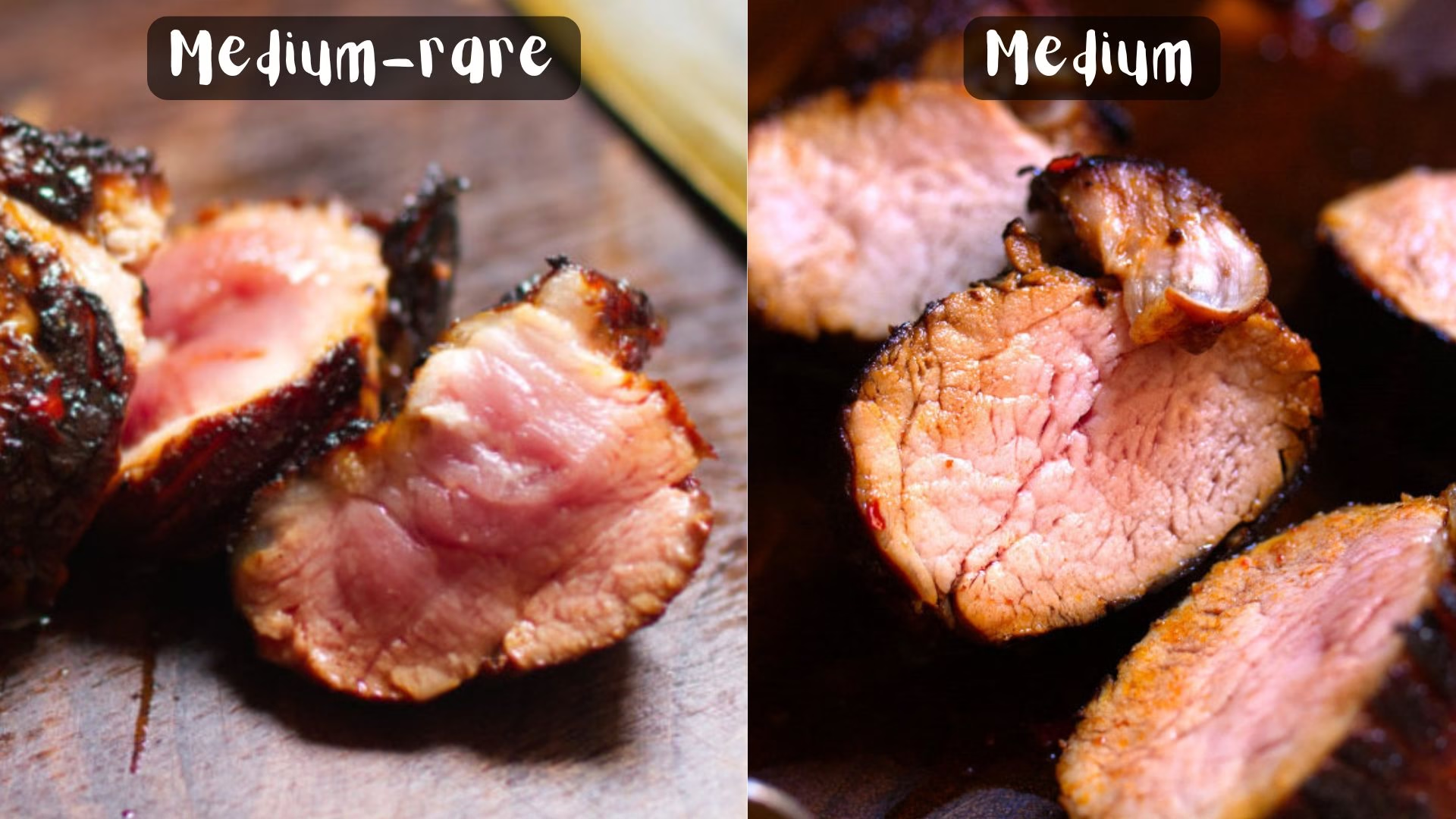
What is Presa ibérica
Presa ibérica is a prized cut of pork from the Ibérico pig (cerdo ibérico), a native breed from Spain and Portugal.
It comes from the shoulder area, specifically the end of the pork shoulder near the top of the loin. Anatomically, it’s part of the cabeza del lomo (the front end of the loin) but closely associated with the shoulder (paleta). It’s a thick, oval-shaped muscle with abundant marbling.
- It’s a well-marbled, relatively thick cut (about 1–1.5 inches), considered one of the most flavorful parts of the Ibérico pig.
- Because Ibérico pigs are often fed acorns (bellota) during the montanera season, the meat develops a rich, nutty flavor and high intramuscular fat content, similar to wagyu beef but with a distinct pork character.
- The texture is juicy and tender, and the fat melts beautifully when cooked.
- In Spanish gastronomy, presa ibérica is often grilled, seared, or roasted, typically served medium-rare to preserve its succulence.
It’s different from other Ibérico cuts like secreto (a thin, marbled skirt-like cut) or pluma (a triangular loin-end cut).
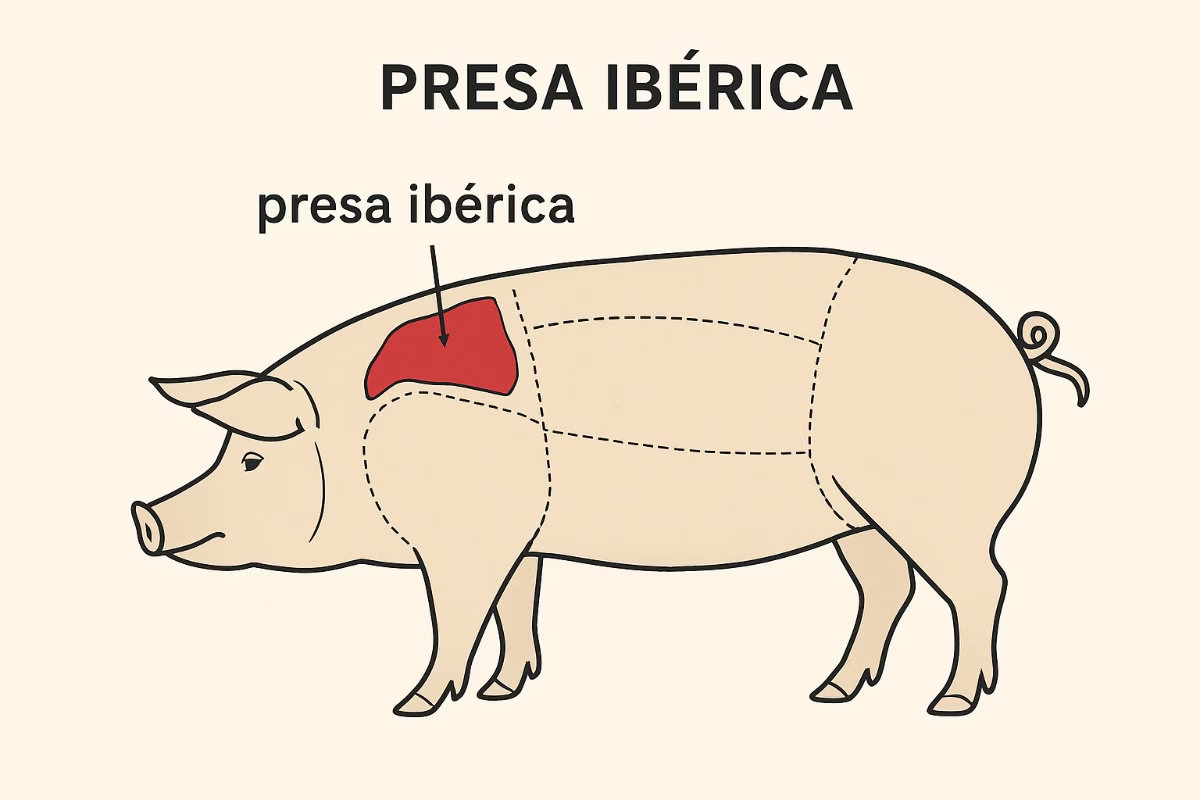
What other cuts of pork can be used to make this recipe?
If you can’t get presa, here are some substitutes depending on cooking method:
Good substitutes for grilling / searing (steak-style):
- Pluma ibérica – very tender, triangular cut from the end of the loin; similar fat content.
- Secreto ibérico – thin, marbled cut from near the shoulder; cooks quickly, very juicy.
- Pork collar (coppa / cabecero de lomo) – richly marbled, close in texture and flavor, more common outside Spain.
For roasting / pan-searing:
- Pork shoulder steak – not quite as refined, but has good marbling and flavor.
- Pork tenderloin (solomillo) – leaner, but still tender; you’ll lose some of the richness.
- Pork loin (lomo) – needs careful cooking to avoid drying out; benefits from marinating or barding with fat.

Add sweetness to your marinade with Pedro Ximénez sherry
Pedro Ximénez, often called PX, is one of Spain’s most luxurious and indulgent sherries. Made from sun-dried Pedro Ximénez grapes, this dark, syrupy wine is renowned for its rich sweetness, with notes of raisins, figs, toffee, and molasses.
Traditionally enjoyed as a dessert wine, PX also pairs beautifully with aged cheeses, chocolate, and even savory dishes like roasted pork, adding depth and a touch of Spanish elegance to the dining experience.
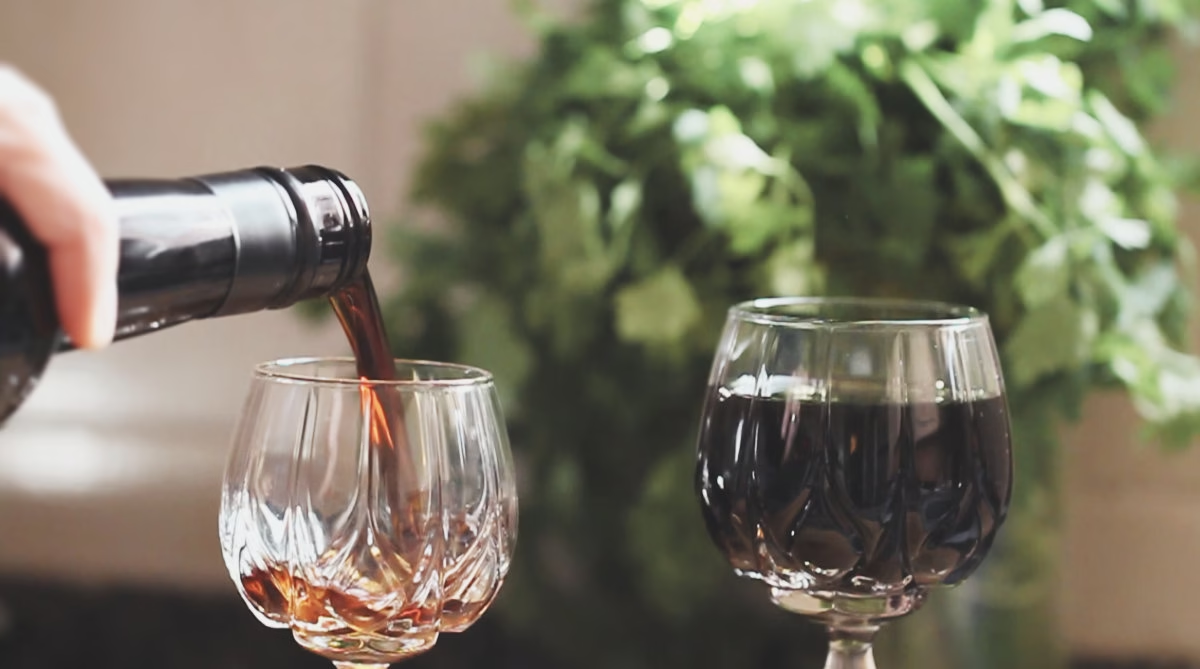
Spanish Wine and Sherry Pairings
This dish has a wonderful combination of flavors: umami (soy), sweetness (honey), smokiness (paprika), and nuttiness (walnuts). So, you want a wine that complements richness but doesn’t overpower the overall flavor of the dish.
Here are a few options:
🍷 Spanish Wine Pairings
- Ribera del Duero (Tempranillo) – Bold, structured, with dark fruit and spice; pairs beautifully with marbled pork.
- Rioja Reserva (Tempranillo blend) – Softer tannins, notes of dried fruit, leather, and vanilla; balances the honey and paprika.
- Priorat (Garnacha & Cariñena) – Intense, mineral-driven red; ideal if you want something robust and earthy.
🍷 Sherry Pairing
- Pedro Ximénez Sherry – Made from sun-dried Pedro Ximénez grapes, this dark, syrupy wine is renowned for its rich sweetness, with notes of raisins, figs, toffee, and molasses.
- Amontillado Sherry – Nutty, dry, and complex; echoes the walnuts in the dish and lifts the umami.
- Oloroso Sherry – Richer, deeper, slightly oxidative; perfect with the caramelization from the honey marinade.
👉 If you’re serving this as a main course, I’d go with a Ribera del Duero or Rioja Reserva. If it’s a tapa or smaller plate, an Amontillado sherry would be stunning.
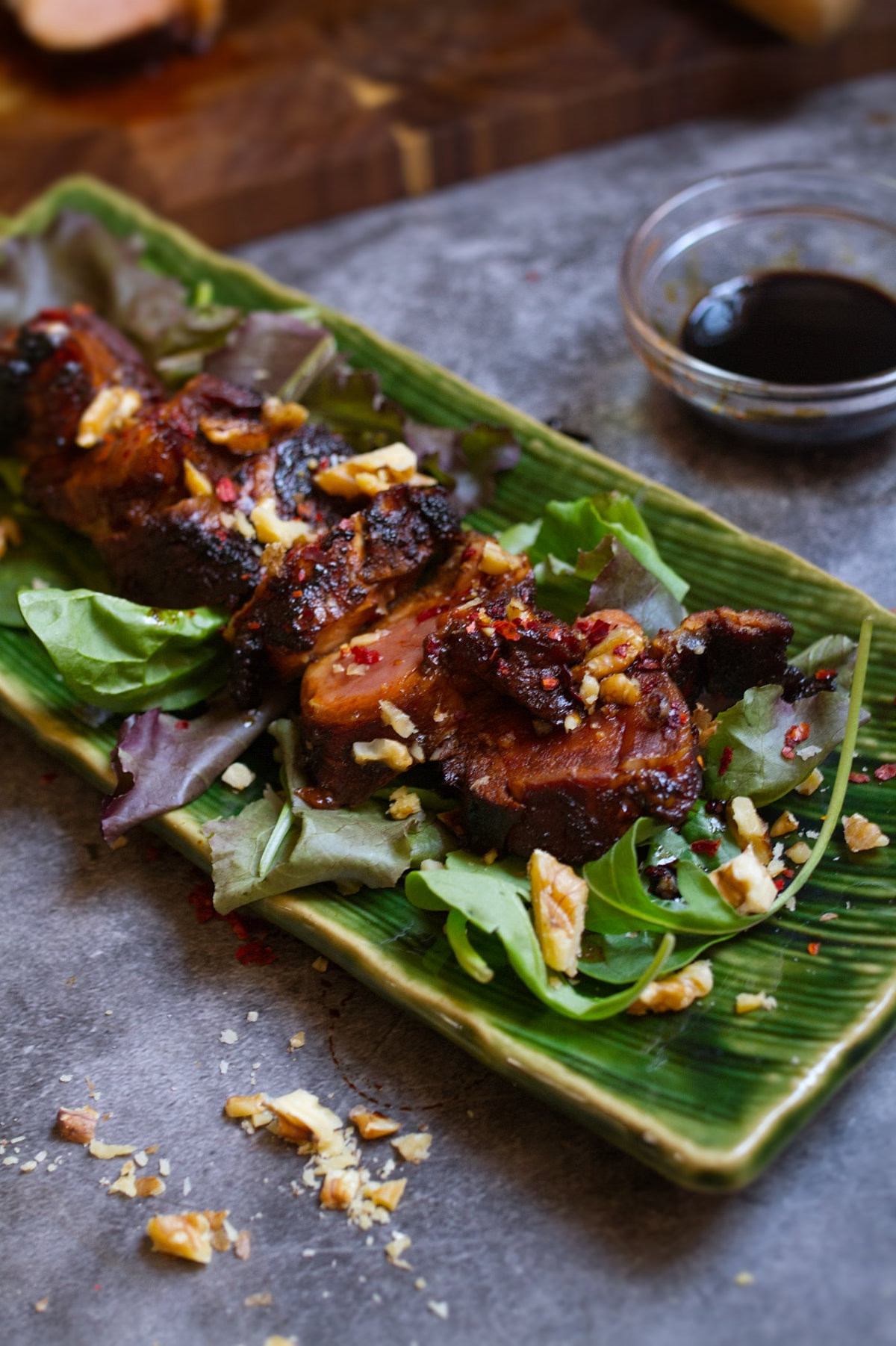
What are Ñora Peppers
Ñora peppers are small, round, sweet red peppers from Spain, particularly associated with the Murcia and Valencia regions. They’re prized for adding flavor and color to dishes, and are used in many of Spain’s most famous dishes. Ñoras are like the sweet, round, Spanish cousin of chili peppers—there for flavor and color, not for heat.
Key details:
- Appearance: About the size of a golf ball, ñora peppers turn deep red to burgundy color when dried, with a wrinkled skin.
- Flavor: Sweet, earthy, and slightly smoky, but not spicy. They give dishes depth and a gentle sweetness without heat.
- Use: Usually sold dried; the skin is tough, so they’re often soaked in warm water and the flesh is scraped out to make pastes or added to sauces.
- Culinary role: A key ingredient in many traditional Spanish recipes—especially sofrito sauces, paella, fideuà, and some even add ñora peppers to romesco sauce.
- Relation to paprika: While they’re different from pimentón (Spanish paprika), pimentón is traditionally made from peppers of the same variety or closely related ones.
Where to buy Ñora Peppers outside of Spain
Ñora peppers are exported all over the world, either packaged dried and whole or dried flakes. Here are a few brands you can buy online:
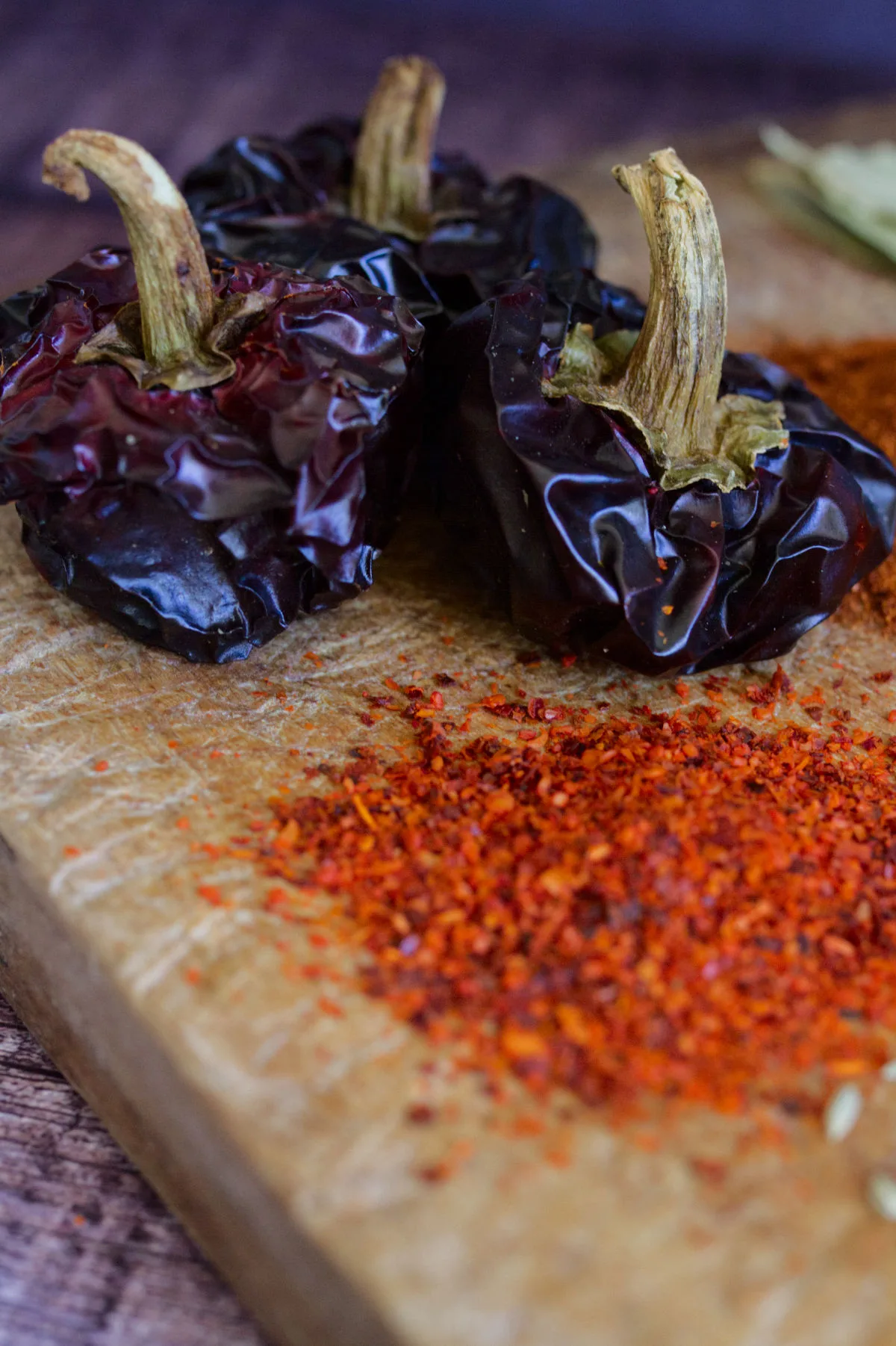
Nutrition Facts (per serving)
(for 125 g pork collar + marinade + walnuts)
|
Nutrient |
Amount |
%DV* |
|
Calories |
~345 kcal |
17% |
|
Protein |
26 g |
52% |
|
Total Fat |
23 g |
29% |
|
– Saturated Fat |
6 g |
30% |
|
– Monounsaturated Fat |
11 g |
— |
|
– Polyunsaturated Fat |
3 g |
— |
|
Carbohydrates |
9 g |
3% |
|
– Sugars |
8 g |
16% |
|
Fiber |
1 g |
4% |
|
Cholesterol |
85 mg |
28% |
|
Sodium |
650 mg |
28% |
|
Potassium |
540 mg |
12% |
|
Iron |
2 mg |
11% |
|
Vitamin B12 |
0.9 µg |
38% |
|
Magnesium |
40 mg |
10% |
*%DV = Daily Value percentages, based on a 2,000 kcal diet.
⚖️ Notes on the calculation:
- Main fat and protein contribution is from pork collar.
- Soy + honey bring sodium and sugars.
- Walnuts add healthy monounsaturated fats, some fiber, and magnesium.
- Cooking will slightly reduce sugars (caramelization), but values are close.
FAQs
Q1: What cut of meat is Presa Ibérica?
A: Presa Ibérica comes from the shoulder area of the Iberian pig. It’s a highly marbled, tender cut known for its rich, juicy flavor.
Q2: Can I substitute Presa Ibérica with another cut?
A: If Presa Ibérica isn’t available, you can use pork tenderloin or pork shoulder, though the flavor and texture won’t be as luxurious.
Q3: How long should I marinate Presa Ibérica?
A: At least 2 hours is recommended, but marinating overnight enhances the flavors for a deeper, richer taste.
Q4: What’s the best doneness for Presa Ibérica?
A: Medium-rare to medium (58–62°C / 136–144°F) is ideal to keep the pork juicy and tender.
Q5: What wines pair well with this dish?
A: Bold Spanish reds like Rioja or Ribera del Duero complement the smoky, nutty flavors beautifully.
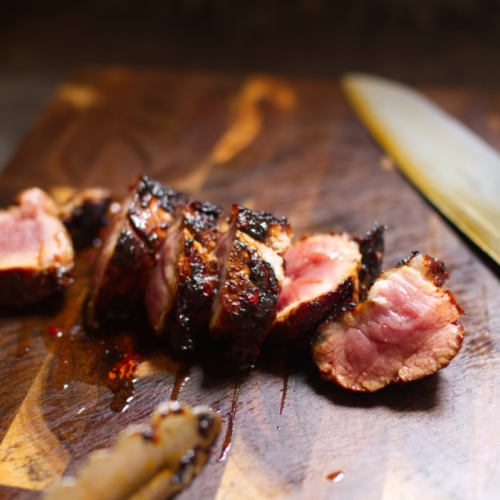
Marinated Presa Ibérica with Walnuts | Gourmet Spanish Pork Made Simple
Equipment
- large bowl
- Wooden cutting board
- Chef knife
- Cooking Tongs
- Large skillet or pan
Ingredients
- 2 pieces of presa ibérica around 500g
- ¼ cup Dark Soy Sauce
- 60 ml Pedro Ximénez sherry optional
- 2 Tbsp Honey
- Extra Virgin Olive Oil
- 1 tsp Sweet smoked paprika
- 1 tsp Dried ñora pepper flakes
- Salt and Pepper to taste
- A few walnuts loosely chopped
Instructions
Step 1 - Marinate Pork
- Combine the soy sauce, honey, paprika, Ñora peppers flakes, and olive oil in a large bowl. If using, add the Pedro Ximénez sherry.¼ cup Dark Soy Sauce, 60 ml Pedro Ximénez sherry, 2 Tbsp Honey, Extra Virgin Olive Oil, 1 tsp Sweet smoked paprika, 1 tsp Dried ñora pepper flakes
- Mix well until the honey has combined with the soy and made a rich, slightly syrup-like sauce.
- Check flavoring and season to taste with salt and pepper. Note: Add more honey if you prefer a sweeter-flavored marinade.Salt and Pepper
- Add the pork and rotate in the marinade so each piece is evenly covered.2 pieces of presa ibérica
- Cover bowl with kitchen wrap and refrigerate for at least 2 hours (or overnight for best results).
Step 2 - Pan Fry pork
- Add a splash of olive oil to a pan on medium-high heat.
- Add each pork fillet and cook for around 2-3 minutes per side (around 10-12 minutes in total for medium-rare).
- Set cooked pork aside to rest for 2-3 minutes.
- Meanwhile, loosely chop a few walnuts and set aside.A few walnuts
Step 3 - garnish and serve
- Lay a bed of greens on a serving plate.
- Slice the cooked pork into bite-sized slices and add to the serving plate.
- Drizzle with some more soy sauce and garnish with a few chopped walnuts.
Video
Notes
Chef’s Tips for the Perfect Marinated Presa Ibérica with Walnuts
- Marinate Overnight for Maximum Flavor – While 2 hours works well, letting the presa ibérica soak in the marinade overnight enhances its tenderness and allows the smoky-sweet flavors to fully penetrate the meat.
- Cook to Medium-Rare – This cut of Iberian pork is best enjoyed medium-rare to medium (about 58–62°C / 136–144°F internal temperature). Overcooking can dry it out, so use a meat thermometer for precision.
- Toast Your walnutss – Lightly toasting the walnuts before chopping brings out their natural oils and intensifies the nutty aroma, adding a gourmet touch to the dish.
- Pair with Spanish Wine – For the ultimate dining experience, serve your Marinated Presa Ibérica with Walnuts with a bold Rioja or Ribera del Duero. The robust red wine complements the richness of the pork beautifully.
A note on cooking times:
I like to cook this cut of pork to medium-rare, which takes around 10-12 minutes on a high heat. You’ll notice in the video that the center of the meat is very rare (pink). If you prefer a more well-done texture, increase cooking time to suit.Love this recipe?
Leave us a comment and tell us your favorite Spanish recipe!
4 Comments
Submit a Comment
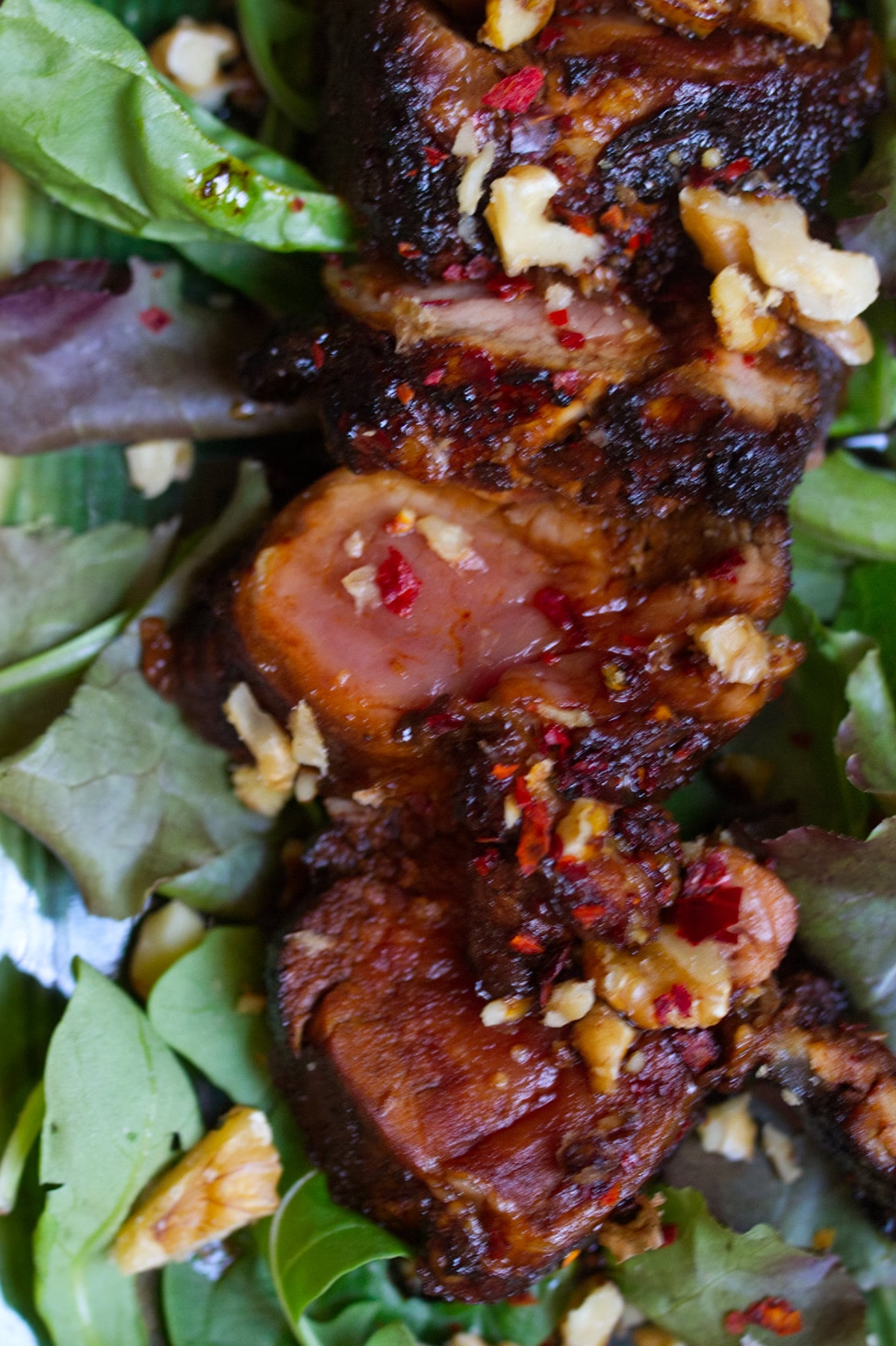

Just yummmmm!
Thank for commenting. this recipe is amazing, we really love it!
WOW
Thank you. Glad you enjoyed the recipe!